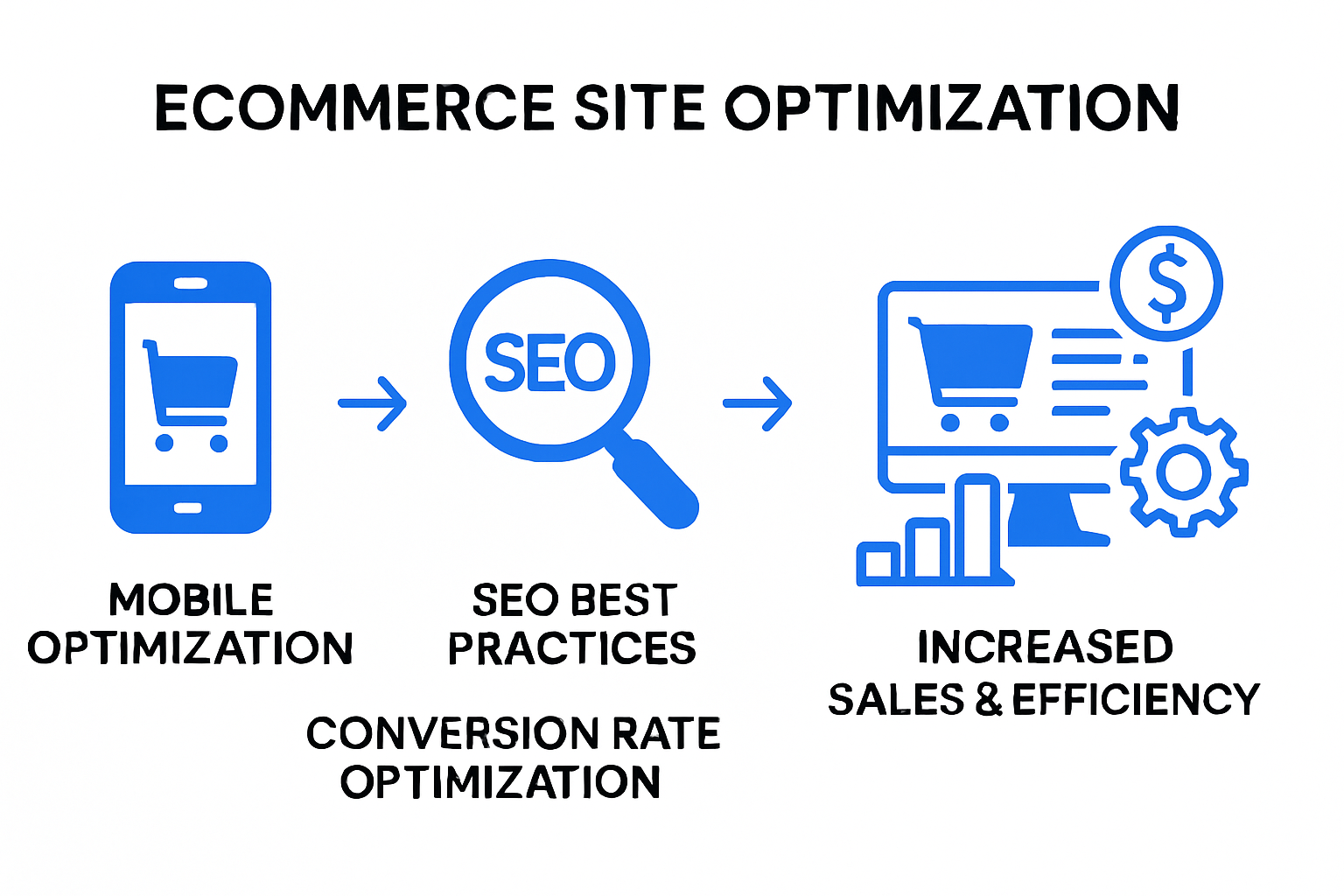Ecommerce Site Optimization Strategies for 2025: Boost Sales and Efficiency
Online stores stand or fall based on how fast and easy they are to use, especially with over 70 percent of all shopping now done on mobile devices. Here is something most people miss. Even a single extra second of page load time can drop your conversion rate by up to 20 percent. That means the smallest delay could cost you thousands in lost sales, so the old way of setting up an ecommerce site is not just risky, it is outdated.
Table of Contents
- Maximizing Site Speed And Mobile Experience
- SEO Best Practices For Ecommerce Websites
- Conversion Rate Optimization For Higher Sales
- Leveraging Analytics To Drive Continuous Growth
Quick Summary
| Takeaway | Explanation |
|---|---|
| Prioritize Mobile Optimization | Over 70% of online shopping occurs on mobile, making site speed and responsiveness critical for enhancing user experience and conversion rates. Implement responsive design and technical optimization strategies to improve mobile performance. |
| Implement SEO Best Practices | Focus on strategic keyword optimization, technical SEO with structured data, and high-quality content to enhance organic visibility and drive traffic to ecommerce sites. |
| Continuously Optimize Conversion Rates | Analyze user behavior and interaction patterns to refine the shopping experience. Prioritize a simplified checkout process, clear product descriptions, and balanced visual design to increase conversions. |
| Leverage Advanced Analytics | Utilize sophisticated analytics tools for performance measurement and data-driven decision making. This includes tracking key performance indicators and using predictive modeling to anticipate customer behavior. |
| Adopt a Culture of Continuous Improvement | Recognize that optimization is an ongoing process. Regularly test hypotheses, monitor performance metrics, and adapt strategies based on evolving consumer trends and behaviors. |

Maximizing Site Speed and Mobile Experience
Mobile optimization has become a critical component of ecommerce site performance. With over 70% of online shopping now happening on mobile devices, businesses cannot afford to ignore the mobile user experience. Speed and responsiveness are no longer optional features but essential elements of successful digital commerce strategies.
The Critical Role of Mobile Page Performance
Website performance directly impacts user engagement and conversion rates. Research from Google reveals that a one-second delay in mobile page load time can decrease conversion rates by up to 20%. This stark statistic underscores the importance of optimizing site speed and mobile responsiveness.
Responsive design ensures that your ecommerce site adapts seamlessly across different devices and screen sizes. By implementing a fluid layout that automatically adjusts elements like images, text, and navigation menus, businesses can provide a consistent and user-friendly experience. According to the Ecommerce Marketing Institute , key strategies for mobile optimization include:
- Responsive Layout : Ensure your design scales perfectly across smartphones, tablets, and desktops
- Touch-Friendly Elements : Create larger buttons and interactive elements for mobile users
- Simplified Navigation : Streamline menus and reduce complex multi-level navigation
Technical Optimization Strategies
Technical performance plays a crucial role in mobile user experience. Compression techniques, efficient coding, and strategic use of content delivery networks can dramatically improve site speed. By reducing image file sizes, minimizing HTTP requests, and leveraging browser caching, businesses can create lightning-fast mobile experiences.
Advanced optimization techniques include:
- Image Compression : Reduce file sizes without sacrificing visual quality
- Browser Caching : Store frequently accessed resources locally for faster subsequent loads
- Content Delivery Networks (CDNs) : Distribute content across global servers to reduce latency
One critical metric to monitor is mobile page load time. VWO research suggests that mobile pages should load within 2-3 seconds to maintain optimal user engagement. Businesses can use tools like Google PageSpeed Insights to diagnose and address performance bottlenecks.
Ultimately, mobile optimization is not just about technical performance but creating an intuitive, smooth user journey. By prioritizing speed, responsiveness, and user-centric design, ecommerce sites can significantly enhance their mobile conversion rates and overall digital success.
Remember that mobile optimization is an ongoing process. Regular performance audits, user testing, and staying updated with emerging mobile technologies will help businesses maintain a competitive edge in the rapidly evolving digital commerce landscape.
To help clarify the most effective strategies and their impacts, the following table summarizes technical optimization methods for speeding up ecommerce sites on mobile:
| Optimization Technique | Benefit | Implementation Tip |
|---|---|---|
| Image Compression | Faster page loads, lower data usage | Use next-gen formats (WebP/AVIF) |
| Browser Caching | Quick repeat visits, reduced server load | Set appropriate cache headers |
| Content Delivery Networks (CDNs) | Lower latency, faster global load times | Choose a CDN with many edge locations |
| Minimize HTTP Requests | Reduced load times, less server strain | Consolidate scripts and stylesheets |
| Responsive Layout | Seamless experience on any device | Use flexible grids and media queries |
SEO Best Practices for Ecommerce Websites
Search engine optimization represents a critical strategy for ecommerce websites seeking to increase organic visibility and drive targeted traffic. Unlike traditional websites, ecommerce platforms require a nuanced approach to SEO that balances technical optimization with compelling content and user experience.
Strategic Keyword Optimization
Keyword research forms the foundation of effective ecommerce SEO. Businesses must focus on understanding user intent and selecting keywords that reflect purchasing behaviors. Research from Ahrefs indicates that long-tail keywords with specific product attributes can drive higher conversion rates compared to generic search terms.
Effective keyword strategies include:
- Product-Specific Keywords : Target detailed product descriptions and specifications
- Buyer Intent Keywords : Focus on terms indicating purchase readiness
- Semantic Variations : Include related search terms and natural language queries
Technical SEO and Structured Data
Technical optimization goes beyond traditional SEO practices for ecommerce websites. Google’s Developers Guide emphasizes the importance of structured data to enhance product visibility. Implementing Schema markup provides search engines with explicit product information, enabling rich snippets that can significantly improve click-through rates.
Key technical optimization elements include:
- Mobile-First Indexing : Ensure responsive design and mobile compatibility
- Page Speed Optimization : Minimize load times and improve performance
- Structured Data Implementation : Use Schema markup for products, reviews, and pricing
Content and Link Building Strategies
Content remains a powerful driver of ecommerce SEO. Developing comprehensive product descriptions, creating informative blog posts, and generating user-generated content can establish authority and improve search rankings. Moz research suggests that detailed, unique content can differentiate products in competitive markets.
Effective content and link building approaches involve:
- Comprehensive Product Descriptions : Write unique, detailed explanations
- Customer Review Integration : Encourage and showcase user feedback
- Strategic Internal Linking : Connect related products and content
Successful ecommerce SEO requires a holistic approach that combines technical optimization, strategic keyword targeting, and high-quality content. By continuously monitoring performance metrics and adapting to search engine algorithm changes, businesses can develop robust organic visibility strategies that drive traffic and conversions.
To summarize the key SEO focus areas for ecommerce websites, the following table outlines each pillar and its specific strategies:
| SEO Pillar | Example Strategies | Impact |
|---|---|---|
| Keyword Optimization | Long-tail, product-specific, buyer intent keywords | Higher conversion, relevant traffic |
| Technical SEO | Structured data, mobile-first, speed optimization | Improved search visibility, rich results |
| Content & Link Building | Unique descriptions, reviews, internal linking | Authority, better rankings, engagement |
Conversion Rate Optimization for Higher Sales

Conversion rate optimization represents a strategic approach to transforming website visitors into paying customers. By systematically analyzing and improving various elements of the digital shopping experience, businesses can significantly enhance their sales performance and return on investment.
Understanding Conversion Dynamics
Research from the Journal of Marketing Analytics reveals that successful conversion optimization requires a comprehensive framework identifying specific sales-influencing touchpoints. This approach goes beyond simple website modifications and demands a nuanced understanding of user behavior and interaction patterns.
Key conversion metrics businesses should track include:
- Visitor to Purchase Ratio : Percentage of site visitors completing a transaction
- Average Order Value : Total monetary value per completed purchase
- Cart Abandonment Rate : Percentage of users who add items but do not complete checkout
Strategic User Experience Design
A comprehensive study in the International Journal of Systems Applications emphasizes that website quality directly correlates with e-commerce performance. Creating an intuitive, frictionless user experience becomes paramount in driving conversions.
Effective strategies for optimizing user experience include:
- Simplified Checkout Process : Reduce steps and minimize required information
- Clear Product Descriptions : Provide comprehensive, easily digestible details
- High-Quality Product Imagery : Use multiple angles and zoom capabilities
Visual Intensity and Conversion Balance
Researchers exploring website design discovered a critical insight: visual intensity impacts user conversion rates non-linearly. Excessive visual elements can actually diminish user engagement and purchase likelihood.
Recommendations for balanced visual design:
- Gradual Visual Enhancement : Incrementally introduce design elements
- User-Centric Layout : Prioritize clarity over complex graphic treatments
- Performance-Driven Design : Ensure visual elements do not compromise page load speed
Successful conversion rate optimization requires continuous testing, measurement, and refinement. By adopting a data-driven approach that balances technical performance, user experience, and strategic design, businesses can create a compelling digital environment that naturally guides potential customers toward making a purchase.
Remember that conversion optimization is not a one-time effort but an ongoing process of understanding user behavior, testing hypotheses, and implementing incremental improvements that collectively drive significant business growth.
Leveraging Analytics to Drive Continuous Growth
Analytics has transformed from a passive reporting tool to a dynamic strategic asset for ecommerce businesses. By systematically collecting, analyzing, and interpreting data, companies can make informed decisions that drive continuous growth and competitive advantage.
Advanced Performance Measurement
Research from the Central European Journal of Operations Research reveals the critical importance of sophisticated analytics in optimizing online marketing budget allocation. Modern analytics platforms provide granular insights that go far beyond traditional metrics, enabling businesses to understand complex customer behaviors and market dynamics.
Key performance indicators businesses should prioritize include:
- Customer Acquisition Cost : Precise measurement of marketing investment efficiency
- Lifetime Value Projection : Predicting long-term customer revenue potential
- Cohort Analysis : Understanding behavior patterns across different customer segments
Data-Driven Decision Making
The Journal of Marketing Analytics highlights a comprehensive framework for utilizing analytics in digital retail environments. By transforming raw data into actionable insights, businesses can create targeted strategies that respond dynamically to emerging market trends.
Effective data-driven strategies involve:
- Predictive Customer Modeling : Anticipate purchasing behaviors
- Real-Time Performance Tracking : Monitor key metrics continuously
- Personalization Algorithms : Customize user experiences based on individual data profiles
Innovation and Sustainable Growth
An empirical study in Sustainability demonstrates how innovation-driven analytics can foster sustainable e-commerce growth. By integrating advanced analytical tools, businesses can develop more responsive, efficient, and customer-centric digital strategies.
Innovation-focused analytics approaches include:
- Machine Learning Insights : Leverage AI for sophisticated pattern recognition
- Cross-Platform Data Integration : Combine data from multiple sources for holistic understanding
- Continuous Experimentation : Implement data-backed testing and optimization
Successful analytics implementation requires more than just collecting data. It demands a strategic approach that transforms information into meaningful action. Businesses must develop a culture of data literacy, invest in advanced analytical tools, and maintain a flexible mindset that embraces continuous learning and adaptation.
The future of ecommerce belongs to organizations that can effectively turn data into a competitive advantage. By developing robust analytical capabilities, businesses can anticipate market shifts, personalize customer experiences, and create sustainable growth strategies that adapt to an ever-changing digital landscape.
Frequently Asked Questions
What are the key strategies for optimizing an ecommerce site for 2025?
To optimize an ecommerce site for 2025, focus on maximizing site speed, implementing mobile optimization, leveraging SEO best practices, and continuously refining user experience to boost conversion rates.
How important is mobile optimization for ecommerce sites?
Mobile optimization is critical as over 70% of online shopping occurs on mobile devices. Improved site speed and responsive design can significantly enhance user experience and conversion rates.
What are some effective SEO best practices for ecommerce websites?
Effective SEO best practices for ecommerce include strategic keyword optimization, implementing structured data for product visibility, and creating high-quality, unique content to drive organic traffic.
How can I improve conversion rates on my ecommerce site?
To improve conversion rates, simplify the checkout process, enhance product descriptions, provide high-quality images, and ensure a frictionless user experience throughout the shopping journey.
Ready to Make Your Ecommerce Site a Top Performer in 2025?
If you are feeling the pressure to boost site speed, improve mobile usability, and continually lift conversion rates, you are not alone. The business costs of slow load times and poor mobile experience are higher than ever. Your goals from the article—faster pages, smarter SEO, and a seamless shopping experience—can sound overwhelming, but the right partner turns them into a reality. At TRAVLRD , we specialize in custom digital solutions built for growth. We use proven strategies like mobile optimization, robust technical SEO, and analytics-driven design to help online stores not just keep up, but leap ahead.

Put your business in front of more buyers and turn every visit into a sale. Discover how a modern, conversion-first website can change your numbers this year. Visit TRAVLRD’s homepage today to see real case studies and get your free consultation. Don’t wait while competitors move forward. See what a world-class team can do for your brand right now.







